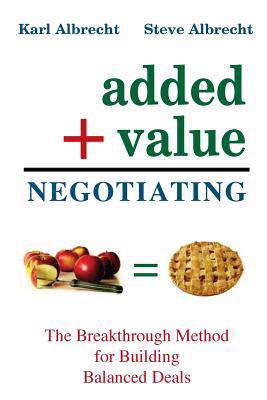
- Afhalen na 1 uur in een winkel met voorraad
- Gratis thuislevering in België vanaf € 30
- Ruim aanbod met 7 miljoen producten
- Afhalen na 1 uur in een winkel met voorraad
- Gratis thuislevering in België vanaf € 30
- Ruim aanbod met 7 miljoen producten
Zoeken
Added Value Negotiating
The Breakthrough Method for Building Better Deals
Steve Albrecht
Paperback | Engels
€ 27,95
+ 55 punten
Omschrijving
The traditional, adversarial approach to negotiating, taught in books, seminars, and business courses all over the world, is a reductive approach: each side seeks to gain as much as possible by minimizing the value obtained by the other. If both parties are "tough negotiators," they'll succeed at the second objective and fail at the first. The result: minimum value for both sides. The age-old rules are known; keep your "opponent" guessing; don't give away too much information about yourself or your needs; negotiate from a position of strength and force your "adversary" to negotiate from weakness; use tricks and gimmicks to throw them off their game. The legacy of tough negotiating is, just as often as not, dissatisfaction, animosity, failed deals, broken agreements, lawsuits, and even war. Had enough of the same old shoving matches and head games? Now, try Added Value Negotiating, the breakthrough five-step method pioneered by Dr. Karl Albrecht and Dr. Steve Albrecht. AVN does not begin with the usual "offer and counteroffer" procedure so commonly used in negotiating. The first stage is an open and candid sharing of interests and objectives by both parties. Once both parties have expressed their interests, the method proceeds to the careful and thorough identification of the possible elements of value that might be involved in meeting the respective interests. This is where the "added value" component comes in. The objective is to build as much value as possible into the deal, not as little as possible. The AVN process then uses various methods for "deal building", which is a cooperative process of constructing several alternative "deal packages", each with a different emphasis on various configurations of value. The concept of multiple options is extremely important, because it replaces the "push-pull" psychology of the offer and counter-offer procedure with a cooperative search for mutually acceptable value. Provide a copy of Added Value Negotiating to every executive, manager, and professional person in your organization.
Specificaties
Betrokkenen
- Auteur(s):
- Uitgeverij:
Inhoud
- Aantal bladzijden:
- 192
- Taal:
- Engels
Eigenschappen
- Productcode (EAN):
- 9780913351222
- Verschijningsdatum:
- 29/12/2008
- Uitvoering:
- Paperback
- Formaat:
- Trade paperback (VS)
- Afmetingen:
- 152 mm x 229 mm
- Gewicht:
- 263 g

Alleen bij Standaard Boekhandel
+ 55 punten op je klantenkaart van Standaard Boekhandel
Beoordelingen
We publiceren alleen reviews die voldoen aan de voorwaarden voor reviews. Bekijk onze voorwaarden voor reviews.











